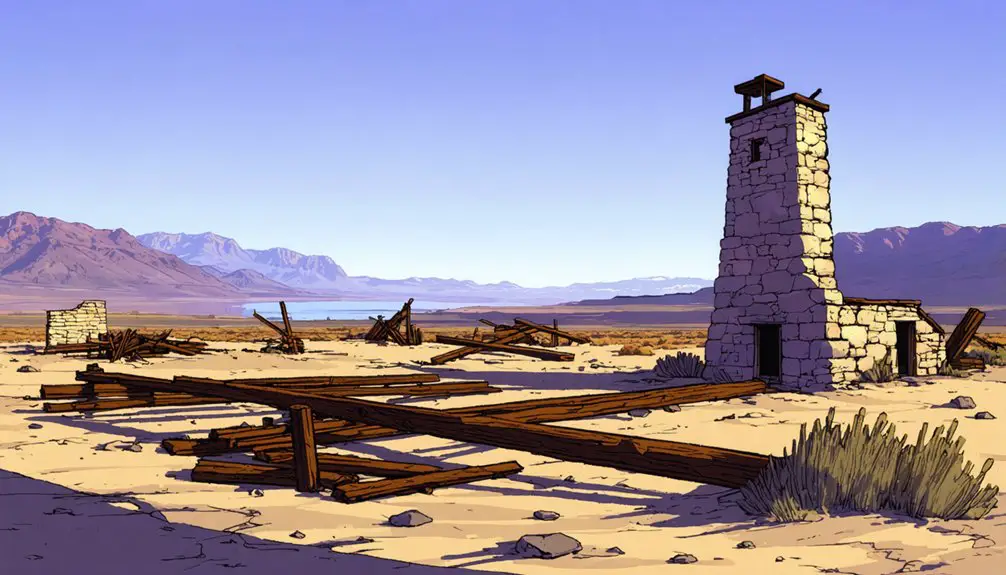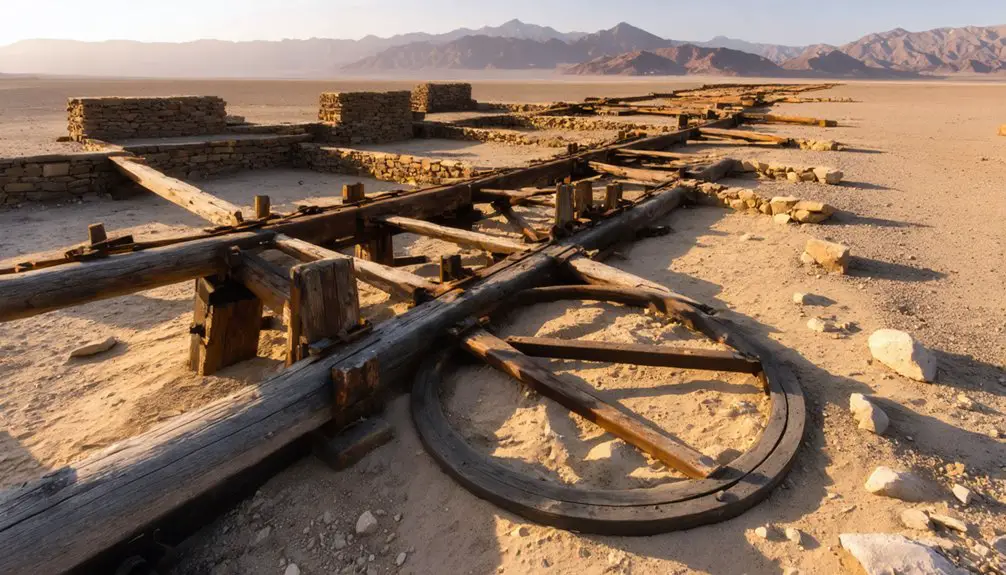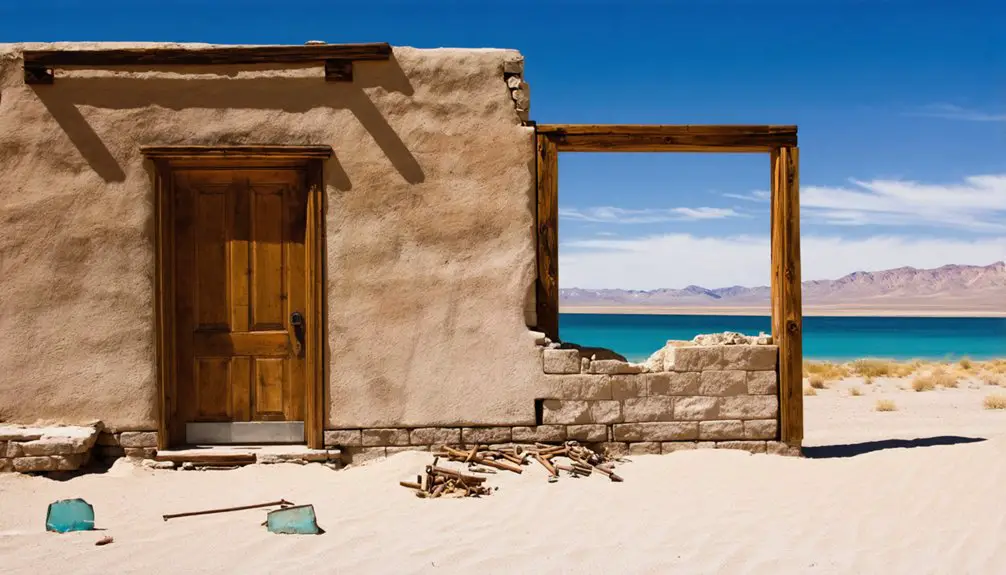You’ll find Rioville along the Colorado River, where Mormon settlers established it in 1869 as an essential transportation hub and river crossing point. The town thrived on river commerce, ferry operations, and trade with nearby mining communities until the 1930s. When Hoover Dam‘s completion created Lake Mead in 1935, Rioville disappeared beneath the rising waters. Today’s fluctuating lake levels occasionally reveal fascinating remnants of this once-bustling settlement’s past.
Key Takeaways
- Rioville was a Mormon settlement established in 1869 along the Colorado River that served as a vital transportation hub and river crossing point.
- The town flourished through river commerce, ferry operations, and trade with nearby mining communities until its abandonment by 1920.
- Rioville disappeared beneath Lake Mead’s waters in 1935 following the completion of Hoover Dam.
- The settlement’s remnants occasionally resurface during Lake Mead’s low water levels, revealing historic foundations and infrastructure.
- The Lost City Museum now preserves artifacts and history from Rioville and other submerged communities in the Lake Mead area.
The Rise of a Colorado River Settlement
When Mormon settlers established Junction City in 1869, they unknowingly placed their community in Nevada rather than Utah Territory, creating what would later become known as Rioville.
You’ll find that these pioneers strategically chose their location along the Colorado River, recognizing its potential as a significant crossing point and transportation hub.
Despite settlement challenges in this remote area, the community quickly developed around essential services.
You’d have seen a bustling ferry operation and general store serving travelers, miners, and settlers moving through the region. The discovery of gold and silver in the late 1800s brought increased traffic through the settlement.
The settlement’s community dynamics centered on river-based commerce, with residents providing critical supplies and transportation services.
The extensive dam system established in later decades would eventually submerge the original townsite, forever altering the landscape that early settlers knew.
While agriculture remained limited, the town’s position at the crossroads of major wagon routes and waterways helped establish its importance in connecting the American West’s expanding territories.
Life Along the Riverbank
Life along Rioville’s riverbank centered on three essential waterways – the Virgin River, the Colorado River, and their confluence point. You’d find a bustling hub of river commerce where steamships docked regularly, bringing supplies and taking local goods to distant markets.
The Mormon settlers who called this place home built a resilient community, adapting to the harsh desert environment while making the most of the river’s resources. Similar to how Rhyolite’s gold rush transformed Nevada’s landscape, the waterways shaped the development of this riverside settlement. Like the miners of Tybo ghost town, the early settlers relied heavily on local American Indian knowledge of the area.
- The settlement’s strategic location supported thriving trade networks with nearby mining towns
- You’d witness daily activities from fishing to loading cargo onto steamships
- Community life revolved around the post office, religious gatherings, and river-based commerce
The waterfront location shaped every aspect of life, from stone buildings designed to withstand floods to farming practices that leveraged the fertile riverbank soil.
Early Transportation and Trade Routes
Beyond Rioville’s riverbank activity, a complex network of transportation routes shaped the region’s economic development.
You’d find railroad connections linking Rioville to booming mining towns like Rhyolite through three major lines: the Las Vegas and Tonopah, Bullfrog Goldfield, and Tonopah and Tidewater railroads, all established between 1906 and 1907.
The mining operations often extracted valuable silica-rich volcanic rock that formed during ancient explosive eruptions in the region. During its peak years of 1907-1908, Rhyolite’s population grew to over 5,000 residents.
Freight logistics relied on a combination of rail spurs, stagecoach routes, and wagon trails. You could spot four daily stagecoaches running north to Goldfield, while railroad sidings serviced Charles Schwab’s massive mill operations.
This transport web enabled rapid movement of ore, mining supplies, and consumer goods, fostering trade networks that connected local camps to national markets.
The Lake Mead Impact
You’ll find Rioville among the many communities that vanished beneath Lake Mead‘s waters when the completion of Hoover Dam in 1935 flooded the valley.
The rising reservoir submerged this once-bustling river settlement, along with other historic sites like St. Thomas and ancient Native American locations, under approximately sixty feet of water.
The Lost City Museum in Overton preserves the rich history of these submerged sites through its collection of ancient artifacts and reconstructions.
With Lake Mead’s water levels dropping considerably since 2002, you can now explore Rioville’s exposed ruins and remnants that tell the story of this lost Nevada town. The reservoir has been facing a severe two decades of drought, leading to unprecedented low water levels that continue revealing these historical sites.
Lake Flooding Erases History
When Hoover Dam‘s construction began filling Lake Mead in 1935, it marked the beginning of the end for several historic Western settlements, including Rioville and St. Thomas.
The flooding consequences were swift and permanent, as rising waters consumed these pioneer communities over three years, submerging structures up to 60 feet beneath the surface.
The Mormon settlers established St. Thomas in 1865, creating a thriving community of around 500 residents.
The submerged history of these towns includes:
- Residents receiving minimal compensation through eminent domain, forcing them to abandon their properties
- Some locals dismantling their homes before the waters rose, while others, like Hugh Lord, defiantly burned their houses
- Physical remnants of Western settlement vanishing underwater, leaving only foundations and chimneys as silent witnesses to the past
Today, fluctuating water levels occasionally reveal these ghost towns, offering glimpses into America’s frontier past. St. Thomas remained hidden until Lake Mead’s recession in 2002 exposed the historic Mormon settlement.
Water Levels Reveal Ruins
The dramatic fluctuations in Lake Mead’s water levels since the early 2000s have created a unique window into the past. As the waters recede, you’ll witness the emergence of Rioville’s forgotten structures – building foundations, partial walls, and remnants of old docks that tell the story of early 20th-century settlement life.
You’ll find archaeological ethics at play as researchers race to document these fragile ruins before they deteriorate from exposure. The site reveals fascinating artifacts from daily life, including mining equipment and household items that have rested beneath the reservoir for decades.
Ruin preservation efforts face the challenge of protecting these historical treasures from both natural erosion and potential looting, while still allowing you to explore this rare glimpse into Nevada’s rich mining and river settlement heritage.
Notable Historical Events and Figures

Among the key figures who shaped Rioville’s history, prospectors Shorty Harris and E.L. Cross made the initial gold discovery that sparked the town’s creation in 1904.
In 1904, prospectors Shorty Harris and E.L. Cross struck gold, laying the foundation for Rioville’s establishment and subsequent development.
The notable figures who followed would shape the town’s destiny through its boom and ultimate economic decline.
- Charles Schwab, a prominent industrialist, invested heavily by purchasing the Montgomery-Shoshone mine for several million dollars in 1906.
- John Cook operated the town’s primary bank during the peak years before selling off assets as the community declined.
- Tom Kelly created the iconic Bottle House from 50,000 bottles, which later became one of the few preserved structures when Paramount Pictures restored it in 1925.
These individuals left their mark on the town before it ultimately succumbed to abandonment by 1920.
Archaeological Discoveries and Remnants
Scattered across Rioville’s desert landscape, archaeological remnants tell a compelling story of the town’s mining prosperity and eventual decline.
You’ll find evidence of over eighty-five mining operations, including foundations, shafts, and industrial equipment that highlight the area’s rich mining heritage.
Archaeological findings reveal the town’s sophisticated infrastructure, from cement sidewalks to a network of 400 electric streetlights.
The historical preservation of commercial structures like the Cook Bank building and the unique Bottle House offers glimpses into daily life.
You can explore the Rhyolite-Bullfrog cemetery, where weathered wooden headboards and unmarked depressions mark the final resting places of early settlers.
The Montgomery-Shoshone mine ruins and scattered mining artifacts stand as evidence to the industrial activities that once drove this frontier community.
Legacy and Historical Significance

You’ll find remarkable parallels between Rioville’s history and other Nevada mining settlements, where hopeful prospectors chased fleeting dreams of striking it rich.
The town’s brief existence captured the quintessential Western mining narrative of rapid growth followed by sudden decline, mirroring the fate of places like Rhyolite and countless other ghost towns dotting Nevada’s landscape.
These abandoned sites now serve as powerful reminders of the volatile nature of mining economies and the transient communities they created in the American West.
Echoes of Mining Dreams
While many mining towns faded into obscurity, Rio Tinto stands as a tribute to Nevada’s rich mining heritage, particularly through its connection to the historic Cope Mining District established in 1868.
You’ll find echoes of ambitious mining dreams in this ghost town, where Samuel Franklyn Hunt and Ogden G. Chase pursued copper ore fortunes well into the 20th century.
The mining heritage of Rio Tinto reflects:
- A unique connection to ancient Spanish copper production spanning 3,000 years
- The evolution from gold and silver mining to copper extraction
- A significant chapter in Nevada mining finance through the Rio Tinto Mining Company’s 1930s stock issuance
Today, you can explore these remnants of Nevada’s industrial past, where each abandoned structure tells a story of economic ambition and the untamed spirit of frontier development.
Mining Boom’s Lasting Impact
The mining boom of Rioville left an indelible mark on Nevada’s economic and social landscape.
Though mining sustainability practices weren’t prioritized during the early 20th century operations, the era’s impact persists through environmental and structural remnants that dot the terrain. You’ll find tailings, abandoned shafts, and infrastructure that tell the story of this once-bustling mining hub.
Beyond physical traces, Rioville’s legacy reveals the challenges of economic diversification strategies in boom-and-bust cycles.
The town’s rise and fall mirrors countless Western mining communities, where capital investment and population growth followed mineral discoveries, only to retreat when resources dwindled.
Today, these ghost town remnants serve as both historical artifacts and cautionary tales, offering valuable insights into Nevada’s resource-driven development and the transient nature of extraction-based economies.
Frequently Asked Questions
Were There Any Major Conflicts Between Rioville Settlers and Native American Tribes?
Like dust settling on troubled waters, you’ll find no major direct conflicts at Rioville, though settler interactions and tribal relations were tense during the broader 1860 Paiute War in nearby regions.
What Types of Crops and Livestock Were Primarily Raised in Rioville?
You’d find impressive crop diversity with corn, wheat, vegetables, and citrus fruits growing alongside melons. For livestock types, settlers raised cattle, sheep, horses, goats, and poultry for sustenance.
How Did Residents Handle Medical Emergencies in Such an Isolated Location?
You’d rely on basic medical supplies from general stores, depend on community knowledge and home remedies, and when things got serious, you’d send riders to nearby settlements for emergency communication and help.
What Games and Entertainment Activities Were Popular Among Rioville’s Inhabitants?
You’d find yourself enjoying saloon social gatherings, card games, and traveling shows. During your free time, you’d participate in fishing, hunting, dancing, and various recreational activities at local establishments.
Did Any Notorious Outlaws or Criminals Ever Pass Through Rioville?
While countless wild tales of outlaw encounters swirl around Western ghost towns, you won’t find solid evidence of notorious criminals in Rioville’s history. Local criminal legends focus on nearby mining towns instead.
References
- https://www.citynibbler.com/home/2018/10/6/1cm1pp6ddibvudaf9hn41tvpct9skc
- https://travelnevada.com/ghost-town/28-excuses-to-hightail-it-to-nevadas-most-photographed-ghost-town/
- https://www.nps.gov/deva/learn/historyculture/rhyolite-ghost-town.htm
- https://www.visittheusa.com/experience/silver-trails-territory-nevadas-mystical-region
- https://en.wikipedia.org/wiki/List_of_ghost_towns_in_Nevada
- https://www.legendsofamerica.com/colorado-river/
- https://en.wikipedia.org/wiki/Colorado_River
- https://nnwrc.navajo-nsn.gov/Public-Education/Water-Rights-History
- https://special.library.unlv.edu/search?keys=&f[0]=subjects:Rioville+(Nev.)&f[1]=type:Archival+Collection
- https://special.library.unlv.edu/ark:/62930/f17s4q



